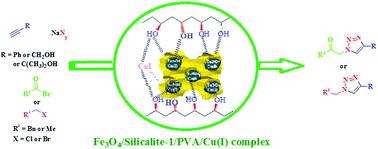当前位置:
X-MOL 学术
›
New J. Chem.
›
论文详情
Our official English website, www.x-mol.net, welcomes your
feedback! (Note: you will need to create a separate account there.)
Design and antibacterial activity assessment of “green” synthesized 1,4-disubstituted 1,2,3-triazoles via an Fe3O4/silicalite-1/PVA/Cu(I) nanocomposite catalyzed three component reaction
New Journal of Chemistry ( IF 2.7 ) Pub Date : 2020-07-14 , DOI: 10.1039/d0nj01984d Afsaneh Taheri Kal-Koshvandi 1, 2, 3, 4 , Mohammad Reza Ahghari 1, 2, 3, 4 , Ali Maleki 1, 2, 3, 4
New Journal of Chemistry ( IF 2.7 ) Pub Date : 2020-07-14 , DOI: 10.1039/d0nj01984d Afsaneh Taheri Kal-Koshvandi 1, 2, 3, 4 , Mohammad Reza Ahghari 1, 2, 3, 4 , Ali Maleki 1, 2, 3, 4
Affiliation

|
Herein, a novel route to produce silicalite-1 via a sol–gel process is presented. After preparation of silicalite-1, an Fe3O4/silicalite-1 nanocomposite, and finally an Fe3O4/silicalite-1/PVA/Cu(I) catalyst are produced by an in situ process. The catalytic performance of Fe3O4/silicalite-1/PVA/Cu(I) in Huisgen 1,3-dipolar cycloaddition has been compared with the catalytic activity of a PVA/Cu(I) nanocomposite, to show the effect of the Fe3O4/silicalite-1 structure. The catalyst could be separated from the mixture with its substantial paramagnetic feature owing to the presence of Fe3O4-NPs. All the necessary structural analyses such as SEM, EDX, FT-IR, TGA, XRD, BET and VSM have been done. This porous heterogeneous catalyst indicates good long-term stability in the air, and also protection of the copper nanoparticles from oxidation. Other advantages of this catalyst are easy separation of the catalyst, milder and green reaction conditions, high yields and short reaction time (∼10 min). Additionally, copper nanoparticles and poly(vinyl alcohol) synergistically act against E. coli and Staphylococcus aureus, and the Fe3O4/silicalite-1/PVA/Cu(I) nanocomposite showed higher antimicrobial activity for E. coli. The antimicrobial activity was determined by using a colony-reduction method. Insertion of amine groups onto the surface of Fe3O4/silicalite-1 has no effect on the antibacterial performance. Moreover, the reusability of Fe3O4/silicalite-1/PVA/Cu(I) is proved.
中文翻译:

通过Fe3O4 / silicalite-1 / PVA / Cu(I)纳米复合物催化的三组分反应“绿色”合成的1,4-二取代的1,2,3-三唑的设计和抗菌活性评估
本文介绍了一种通过溶胶-凝胶法生产silicalite-1的新途径。在制备silicalite-1之后,通过原位方法制备Fe 3 O 4 / silicalite-1纳米复合材料,最后是Fe 3 O 4 / silicalite-1 / PVA / Cu(I)催化剂。已将Fe 3 O 4 / silicalite-1 / PVA / Cu(I)在惠斯根1,3-偶极环加成中的催化性能与PVA / Cu(I)纳米复合材料的催化活性进行了比较,以显示铁3 O 4/ silicalite-1结构。由于存在Fe 3 O 4 -NPs,因此可以从催化剂中分离出具有明显顺磁性特征的催化剂。已经完成了所有必要的结构分析,例如SEM,EDX,FT-IR,TGA,XRD,BET和VSM。这种多孔的非均相催化剂表明在空气中具有良好的长期稳定性,并且还保护了铜纳米颗粒免于氧化。该催化剂的其他优点是催化剂易于分离,反应条件温和,绿色,收率高和反应时间短(约10分钟)。此外,铜纳米颗粒和聚乙烯醇可协同作用对大肠杆菌和金黄色葡萄球菌以及Fe 3 O 4/ silicalite-1 / PVA / Cu(I)纳米复合材料对大肠杆菌具有更高的抗菌活性。通过使用菌落减少法测定抗菌活性。胺基插入到Fe 3 O 4 / silicalite-1的表面上对抗菌性能没有影响。此外,证明了Fe 3 O 4 /硅沸石-1 / PVA / Cu(I)的可重复使用性。
更新日期:2020-07-27
中文翻译:

通过Fe3O4 / silicalite-1 / PVA / Cu(I)纳米复合物催化的三组分反应“绿色”合成的1,4-二取代的1,2,3-三唑的设计和抗菌活性评估
本文介绍了一种通过溶胶-凝胶法生产silicalite-1的新途径。在制备silicalite-1之后,通过原位方法制备Fe 3 O 4 / silicalite-1纳米复合材料,最后是Fe 3 O 4 / silicalite-1 / PVA / Cu(I)催化剂。已将Fe 3 O 4 / silicalite-1 / PVA / Cu(I)在惠斯根1,3-偶极环加成中的催化性能与PVA / Cu(I)纳米复合材料的催化活性进行了比较,以显示铁3 O 4/ silicalite-1结构。由于存在Fe 3 O 4 -NPs,因此可以从催化剂中分离出具有明显顺磁性特征的催化剂。已经完成了所有必要的结构分析,例如SEM,EDX,FT-IR,TGA,XRD,BET和VSM。这种多孔的非均相催化剂表明在空气中具有良好的长期稳定性,并且还保护了铜纳米颗粒免于氧化。该催化剂的其他优点是催化剂易于分离,反应条件温和,绿色,收率高和反应时间短(约10分钟)。此外,铜纳米颗粒和聚乙烯醇可协同作用对大肠杆菌和金黄色葡萄球菌以及Fe 3 O 4/ silicalite-1 / PVA / Cu(I)纳米复合材料对大肠杆菌具有更高的抗菌活性。通过使用菌落减少法测定抗菌活性。胺基插入到Fe 3 O 4 / silicalite-1的表面上对抗菌性能没有影响。此外,证明了Fe 3 O 4 /硅沸石-1 / PVA / Cu(I)的可重复使用性。











































 京公网安备 11010802027423号
京公网安备 11010802027423号